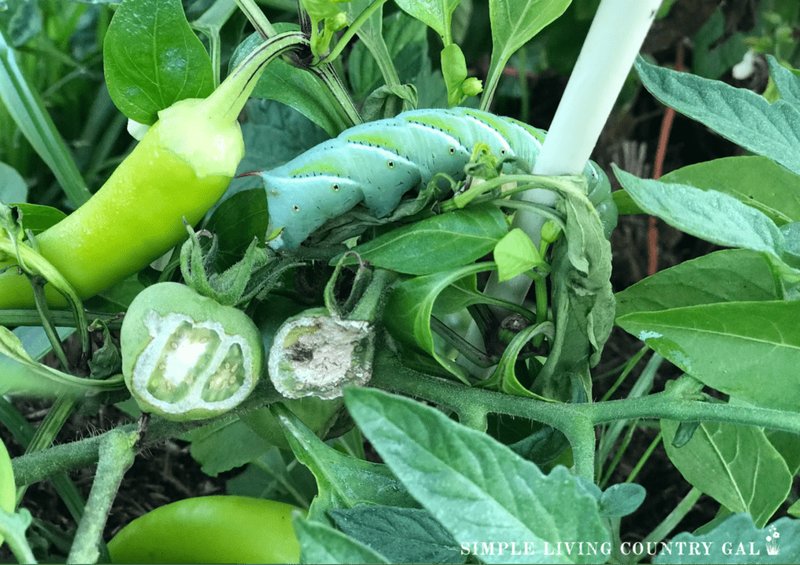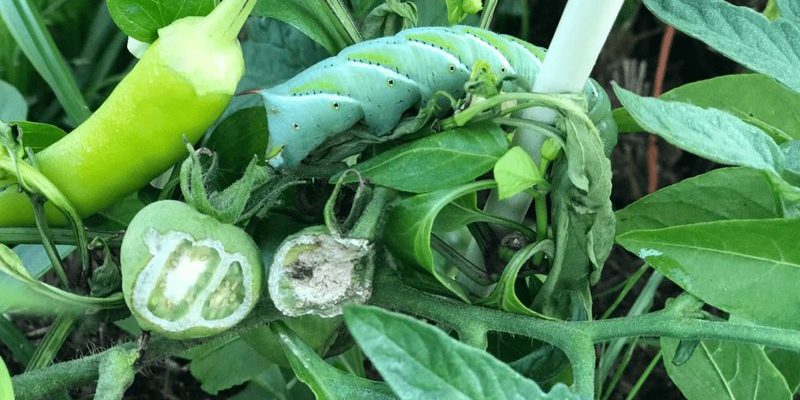
Let’s dive into what hornworms are, why they can be problematic, and how companion planting can save the day. Picture your garden as a mini-ecosystem. Every plant has its friends (and foes) that can either help them flourish or turn into a buffet for pests. So, grab your coffee, and let’s explore this fascinating world together!
What Are Hornworms?
Hornworms, particularly the *five-spotted hawk moth larvae*, are the larval stage of a beautiful moth. They’re often green with a distinguishable horn-like projection on their rear, which is where they get their name. Honestly, they can be shocking to discover in your garden due to their size—they can reach up to four inches long!
These caterpillars love to munch on the leaves and stems of plants, especially tomatoes and peppers. If you’re growing these, you might be wondering if hornworms are the end of your gardening dreams. Spoiler alert: they don’t have to be! While hornworms can cause serious damage, understanding them is the first step in managing their impact effectively.
Why Companion Planting is Important
Companion planting is like creating a supportive community among your plants. Just as friends can help each other out, certain plants can deter pests, attract beneficial insects, or even enhance each other’s growth. For example, planting marigolds alongside your vegetables isn’t just for the pretty flowers; these bright blooms can help keep pests like hornworms away.
Here’s the thing: the right companions can either mask scents that attract pests or lure in predatory insects that feast on hornworms. If you’re looking to grow a bountiful garden without loads of pesticides, companion planting is a fantastic strategy to consider.
Best Companion Plants for Deterring Hornworms
When it comes to deterring hornworms, certain plants can act like the bodyguards of your garden. Here are some top contenders:
- Marigolds: Their strong scent and pest-repelling properties make them a favorite for any garden.
- Basil: Not only does it taste great in your cooking, but it also helps repel hornworms when planted near tomatoes.
- Nasturtiums: These vibrant flowers can confuse pests with their scent and can also attract beneficial insects.
- Garlic: This kitchen staple can deter many pests, including hornworms, with its pungent aroma.
Planting these alongside your favorites can give you a beautiful garden while keeping the hornworm population in check.
Creating a Companion Planting Strategy
To get the most out of companion planting, it’s essential to plan how you lay out your garden. Think of your garden as a jigsaw puzzle where each piece fits together to create a bigger picture. Here are some steps to help you design an effective companion planting strategy:
1. **Research Compatible Plants**: Look into which plants grow well together. For instance, tomatoes pair well with basil and marigolds but not with corn.
2. **Plan Your Layout**: Sketch out a simple layout of your garden. This doesn’t have to be fancy—just mapping out where you’ll place each plant can really help.
3. **Rotate Your Crops**: Each season, try to alternate the placement of your plants. This not only helps with soil health but also keeps pests from settling in.
4. **Monitor Your Garden**: Keep an eye on how your plants are doing together. If you notice hornworms or other pests, you might need to adjust your layout or companion choices.
Natural Predators of Hornworms
Another effective way to keep hornworms under control is by inviting their natural predators into your garden. Think of these helpful creatures as your garden’s secret agents. Here’s how to attract them:
1. **Ladybugs**: These little bugs are not just cute; they love munching on soft-bodied pests.
2. **Parasitic Wasps**: While they might sound scary, these tiny wasps lay their eggs inside hornworms, effectively controlling their population.
3. **Birds**: Attracting birds can help reduce the number of hornworms, as many species love snacking on them. Hanging bird feeders can draw them in.
By encouraging these predators, you create a healthy balance in your garden ecosystem, making it harder for hornworms to overstay their welcome.
When to Employ Companion Planting
Timing is everything in gardening, and companion planting is no exception. The earlier you implement these strategies, the better your chances of keeping those hornworms at bay are. Here’s a simple timeline to help you out:
– **Start Early**: As soon as you plan your garden, think about which companion plants will go where. This will give them time to establish before pests arrive.
– **Regular Maintenance**: Keep assessing your plants to see if they’re thriving together. Are some growing faster? Do you see signs of pests? Timing your interventions is crucial.
– **Observation**: Throughout the growing season, be vigilant. If you spot hornworms or their damage, act fast! Handpicking them off your plants can do wonders.
Common Mistakes to Avoid with Companion Planting
While companion planting can be highly beneficial, some common pitfalls can trip up even the most seasoned gardeners. Here are a few things to keep in mind:
– **Overcrowding**: Planting too closely can lead to competition for nutrients, water, and sunlight. Make sure each plant has enough space.
– **Ignoring Plant Needs**: Different plants have varying water and sunlight needs. Ensure your companions can thrive together in the same environment.
– **Neglect**: Just because you’ve planted companions doesn’t mean you can forget about them! Regular watering, weeding, and monitoring are still essential.
Avoiding these mistakes will help keep your plants healthy and effective at deterring hornworms.
Final Thoughts on Hornworms and Companion Planting
Using companion planting to fend off hornworms is like giving your garden a fighting chance. By choosing the right friends for your plants, you’re not just creating a more colorful and diverse garden—you’re also enhancing the health of your crops and decreasing the chances of pest invasions.
So, the next time you’re out in your garden, take a moment to appreciate the relationships among your plants. They might just surprise you with how well they work together, keeping those pesky hornworms at bay and ensuring a fruitful harvest. Happy gardening!

